Florida's Venomous Snakes
These six species of venomous snakes are native to Florida, these snakes pose a serious deadly threat to humans and pets and should never be approached or handled, If you are bitten by any snake and are unsure of its identity you should seek emergency medical attention.
Eastern Diamondback Rattlesnake, Canebrake Rattlesnake, Pygmy Rattlesnake, Water Moccasin, Coral Snake, Copperhead
Eastern Diamondback Rattlesnake - Crotalus adamanteus
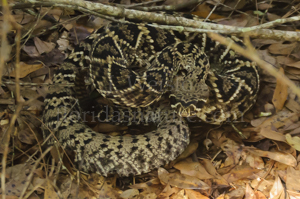
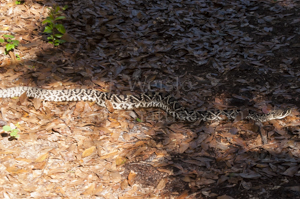
Found in all regions of Florida & although it is most common in pine and palmetto flatwoods they may be found in virtually any type of habitat.
The eastern diamondback rattlesnake is North America's longest and heaviest venomous snake.
This is a very dangerous snake with a lightning fast strike up to 2/3 of its body length, a 3-5 foot eastern diamondback rattlesnake has fangs nearly two-thirds of an inch long and carries more than enough venom in its glands to deliver a fatal bite to an adult human.
When they feel threatened, a Diamondback will usually coil up with its head raised and neck in a -S- position ready to strike. Note - Rattlesnakes do not always rattle, so don't rely on this to warn you of a nearby snake.
Canebrake rattlesnake or Timber rattler - Crotalus horridus

The Timber rattler is present in northern Florida from roughly Volusia county northward on the east coast and from Levy county northward on the west coast. Its range continues north to Maine and west to Texas.
The Timber rattler can be a heavy bodied snake and is best given a wide berth, it has excellent camouflage and tends to lay motionless waiting in ambush for prey. Habitat is generally damp areas near and around cane thickets, low lying hammocks, swamps, river, creek and stream banks. Adults average in size from 3 to 5 feet in length, the official record is 74.5 inches. Timber rattlers have a pattern of brown to black cross bands on a yellowish brown to grayish background. The cross bands have irregular edges and sometimes are "V" or "M" shaped.
Pygmy Rattlesnake - Sistrurus miliarius barbouri
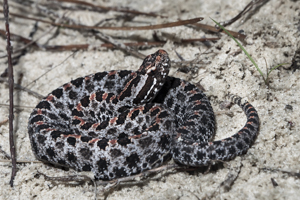
Also found throughout Florida, this small snake measures 18 inches or less in length and although they have lesser quantities of venom than the diamondback rattlesnake it is a more potent "cocktail".
A grey background coloration coupled with its small size can make it difficult to spot. The Pygmy rattlesnake has alternating reddish-copper colored markings along its back.
Pygmy rattlers tend to be aggressive and quick to strike, their rattle can only be heard for a few feet and the sound resembles an insect buzzing.
Cottonmouth or Water Moccasin - Agkistrodon piscivorous conanti
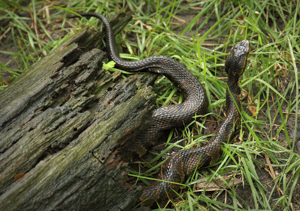
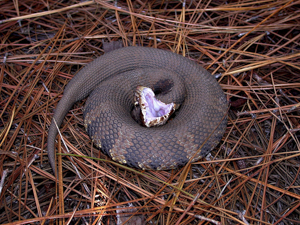
The Cottonmouth grows to over 5 feet in length, with somewhat variable coloration. Water Moccasins range from a bland brownish color to nearly black & may or may not have visible darker cross bands.
As the name implies this is a water snake found around swamps, marshes, lakes and ponds. A nocturnal hunter, it usually rests near the water during daylight hours.
The Cottonmouth is unpredictable in that some individuals are very aggressive, this is the only snake that will sometimes actually pursue anyone that intrudes into its space, whereas other snakes will retreat if possible.
Copperhead - Agkistrodon contortrix
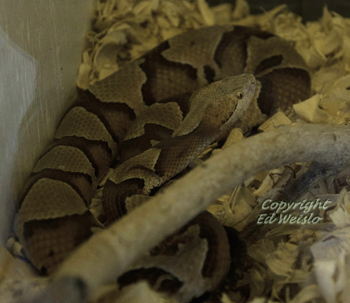
The Copperhead has a limited range within Florida, reported from 7 counties in the western panhandle and Apalachicola river valley.
While bites to healthy adults are usually not fatal, children and those with health problems are at higher risk from this snakes bite.
Average adult Copperhead size is 2 to 3 feet long, maximum recorded size is 53 inches. Light brown to gray cross bands alternate with those of darker brown to reddish brown. Southern Copperheads sometimes have a overall pinkish tint.
Preferred habitat is low lying wet areas in and around swamps, ravines and river beds. A very well camouflaged snake in its native woodlands.
Coral Snake - Micrurus fulvius fulvius
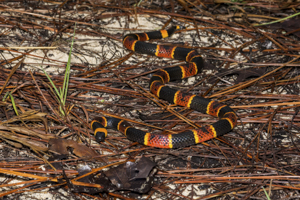
Unlike the other venomous snakes listed here the Coral snake is shy and secretive by nature, spending most of its time burrowing under leaf litter or fallen trees looking for its prey... small snakes, frogs, and lizards. Most bites from the Coral snake come about as a result of careless handling the snake. The coral snake does not have fangs like other venomous snakes, however it more than compensates for this with its very potent venom that is similar to cobra venom, it is a strong neurotoxin.
Symptoms of a bite may be somewhat delayed and include slurred speech, double or blurred vision and difficulty swallowing, possibly progressing to respiratory and cardiac collapse.
The body is banded with black, yellow and red rings with the red and yellow bands touching, this is very similar to the pattern on the harmless native Scarlet Kingsnake however on that snake the red and yellow bands are seperated by black bands and do not touch. Hence the old adage "Red touches yellow kills a fellow, red touches black is a friend of jack". The Coral Snake has a black nose or snout, the Scarlet Kingsnake has a red snout.